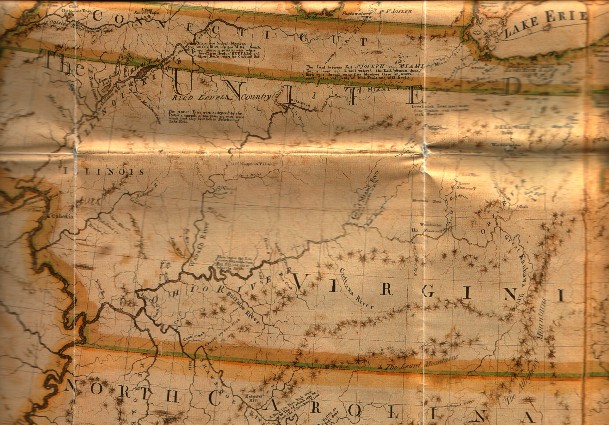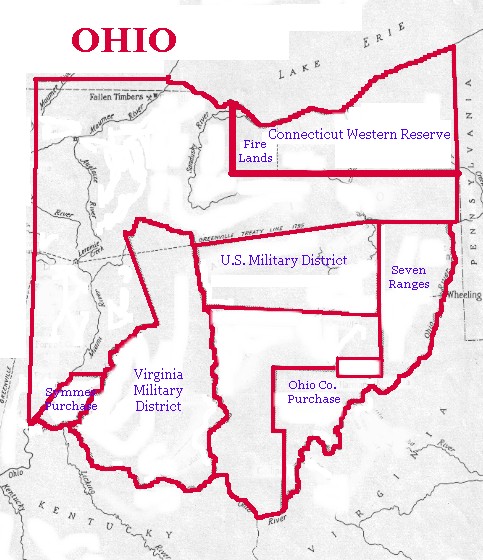
Ohio and the Indian Wars of the Northwest Territory
- Northwest Territory and Indian Wars: 1790 to 1795
- Land Claims and the State of Ohio
- Whiskey Rebellion - 1794
- Virginia's Claim on the Northwest Territory"
- Some Family Histories of the Region
When the U.S. won the Revolution, it acquired the Northwest Territory by the Treaty of Paris in 1783. This happened because George Rogers Clark had defeated the British at Vicennes in 1779. It contained six future states: Ohio (1803), Indiana (1816), Illinois (1818), Michigan (1837), Wisconsin (1848) and Minnesota (1858).
The Shawnee, Wyandotte, Miami and others had fought intrusion by white settlers throughout colonial times and during the Revolution. They had agreed to treaties after the Revolution that left them with only their hunting grounds north of the Ohio River. Now that too was threatened. Pressure for settlement continued; settlers began pushing into the Northwest Territory as early as 1787. The Indians raided the frontier settlements in retaliation. Settlers demanded the government intervene.
The new government saw the Northwest Territory as a huge resource--in land and ultimately revenue to pay the government's debts. Conflicting claims --those of the Indians and also of the states stood in the way.
A commission was appointed in 1783 to negotiate with the various Indian nations to acquire their land in the territory. Treaties with individual tribes were partially successful. Where they were not, troops were sent to take the land by force. Initially the efforts failed because the militias that were deployed were too small and insufficiently trained. Eventually a larger force under the command of a determined General was successful.
The treaties and battles that defined the Indian Wars of 1790 to 1795 are:
- October 1784 - Treaty of Fort Stanwix (did ot include Iroquois)
- January 1785 - Treaty of Fort McIntosh (Wyandotte, Delaware, Chippewa, Ottowa)
- January 1786 - Treaty of Fort Finney (Shawnee--Wabash did not attend)
- 1789 - Treaty of Fort Harmar (Six Nations)
- 1789 - Treaty of Fort Harmar (Wyandotte, Delaware, Chippewa, Ottowa)
- November 1790 - Little Turtle defeats Gen. Harmar
- November 1791 - Little Turtle defeats Gen. St. Clair
- August 1794 - Gen. Wayne defeats Little Turtle at Fallen Timbers
- August 1795 - Greenville Treaty with Delaware, Wyandotte, Shawnee,
Miami, Ottowa, Chippewa, Pottawatomie
and independent tribes.
Land Claims and the State of Ohio
Acquiring the territory from the Native Americans did not solve the problem of controlling settlement. Who was entitled to the land?
How was it to be divided up?
Many states had conflicting claims. The 1783 Abel Buel Map (above) shows the claims of Connecticut and Virginia all the way to the Mississippi. The Federal Government wanted the states to give up their claims. New York complied in 1781, Virginia in 1784, Massachusetts in 1785. Connecticut relinquished part of its claim in 1786 and the rest in 1800. In these cessions Virginia and Connecticut reserved lands within the territory. The Northwest Ordinance of 1787 set up the procedures for statehood, acquiring land and civil rights in the Territory.
Early land districts:
Migration:
The territory was divided into many districts or surveys. Land in these districts could then be sold or used to pay bounties to those who had served in the Revolution. The process took many years. A booklet describing these divisions is available from the Auditor of the State of Ohio, Columbus. These divisions help explain migration patterns in what became the state of Ohio.
The Virginia Military District claimed land for the purpose of paying the military bounty warrants of Virginians who served in the war.
The Connecticut Western Reserve claim derived from a colonial charter. The state sold its reserve land to the private Connecticut Land Company. but a portion of the reserve was set aside by the Connecticut Legislature to compensate residents of Connecticut towns destroyed by the British during the war.
Federal public land survey--the seven ranges of eastern Ohio: The first of these went on sale in
The Ohio Company purchased land in southeastern part of the territory from the Continental Congress in 1787 and was issued patents in 1792. This company was
comprised mainly of Revolutionary officers from
The Symmes Purchase: John Cleave Symmes acquired a patent in the southwest corner of Ohio territory in 1794. Symmes conveyed a large portion of this to
Jonathan Dayton to facilitate pooling of warrants to allow
U.S. Military District was established in 1796 by Act of Congress to grant bounty land to Continental Army officers and soldiers.
Settlement:
The Territorial governor declared Washington as Ohio's official first county. The first settlers congregated around the mouth of the Muskingum River where it flowed into the Ohio. Logs for homes were sent down the Ohio from Pittsburgh and the new town of Marietta began to emerge. Whole Virginia families and towns sent advance guards to select and survey land in Ohio. Pennsylvania families were gradually spreading into the land along the north bank of the Ohio into the slivver of Virginia that is now part of West Virginia.
Whiskey Rebellion
At the Pennsylvania-Virginia frontier along the Ohio River, settlers had endured Indian raids well into the 1790s. They formed militias to protect themselves. They felt they had been given scant support by the new U.S. Government which left them to defend themselves. They became self-sufficient if not fiercely independent and stubborn. But the Scots-Irish in particular had a reputation for being recalcitrant and downright unruly. When the new U.S. government began to impose taxes, the people at the frontier resented it.
One of the first taxes was levied against spirits. In 1794 a corps of inspectors and revenue collectors was dispatched by President Washington to the countryside to search out stills, issue citations and collect taxes. These 'revenuers' entered homes and businesses without notice and demanded immediate payment wherever a still was discovered. Of the 2500 known stills in America most were in the Pittsburgh area of western Pennsylvania. Monongehela Rye was the standard spirit of the young nation.
The mountain people in western Pennsylvania were outraged and incited the Whiskey Rebellion. The rebels burned the home of the local collector and robbed outgoing mail to gather intelligence on government operations. Washington, seizing a great opportunity to show military strength to the British garrisons in the Northwest Territory, sent troops to quell the rebellion. It was suppressed quickly with surprisingly little violence.
After the rebellion things settled down for awhile. The western settlements on the Ohio River were major jumping off places for pioneers poised to overrun the Ohio valley.
Below are limks to family histories of several families who lived through the Whiskey Rebellion: Franks from Dauphin Co. PA who served with the Federal troops; Johnston Calhoun, a recent immigrant from Donegal, Ireland who sold provisions and munitions to the troops, and the old Dawson family originally from Maryland, ferrymen on the Ohio.
It was ironic that the Whiskey Rebellion occurred the same year that, General Wayne defeated Little Turtle at Fallen Timbers.The opening of the Ohio territory for legal settlement was perfectly timed for restless Pennsylvanians and Virginians at the frontier.
Those who had served from Virginia in the Revolution and afterwards at the frontier were given warrants for bounty land in the part of the Northwest Territory designated as the Virginia Military District.
One of the most distinguished regiments of the Revolution had been the Eighth Virginia Regiment commanded by German-speaking General Peter Muhlenberg a Lutheran minister who had come to Woodstock in the Shenandoah Valley of Virginia in 1772. A pragmatic sort, he had obtained ordination also in the Church of England in addition to his native ministry in order to legally carry out his mission in Virginia. When the war broke out he delivered a sermon to his congregation, threw off his clerical garb, and standing in military attire recruited a regiment of his parishioners--all German. They served bravely and achieved notoriety from campaigns in the north, south and far west.
George Rogers Clark, brother of William Clark (Lewis and Clark Expedition) achieved notoriety when he took the British controlled Fort at Kaskaskia in 1777. In the dead of winter he had enlisted two companies of experienced Indian fighters from the Shenandoah Valley. Their experience had been hard-earned. Among his troops were Lewis, John and Robert Painter. (See the story of raids on a family named 'Painter' in the Shenandoah Valley of Virginia in colonial times.) 1.
Family Histories
:Several family histories at this web site pertain to this region in this period:
- Painter of Virginia and Preble Co. OH
- Griffith of Baltimore MD and Belmont, Knox, Muskingum Counties OH
- Frankof Dauphin Co. PA and Montgomery Co. OH
- Calhoun/Dawson of Beaver Co. PA and Columbiana Co. OH
FOOTNOTES:
1. T.K. Cartmell, Shenandoah Valley Pioneers and Their Descendants (Frederick County, VA: 1908).